| Monobathrida | |
|---|---|
 | |
| Cactocrinus imperator | |
| Scientific classification | |
| Kingdom: | |
| Phylum: | |
| Subphylum: | |
| Class: | |
| Subclass: | |
| Order: | †Monobathrida |
| superfamilies | |
| Monobathrida | |
|---|---|
 | |
| Cactocrinus imperator | |
| Scientific classification | |
| Kingdom: | |
| Phylum: | |
| Subphylum: | |
| Class: | |
| Subclass: | |
| Order: | †Monobathrida |
| superfamilies | |

An echinoderm is any member of the phylum Echinodermata. The adults are recognisable by their radial symmetry, and include starfish, brittle stars, sea urchins, sand dollars, and sea cucumbers, as well as the sea lilies or "stone lilies". Adult echinoderms are found on the sea bed at every ocean depth, from the intertidal zone to the abyssal zone. The phylum contains about 7,000 living species, making it the second-largest grouping of deuterostomes, after the chordates. Echinoderms are the largest entirely marine phylum. The first definitive echinoderms appeared near the start of the Cambrian.

Crinoids are marine animals that make up the class Crinoidea. Crinoids that are attached to the sea bottom by a stalk in their juvenile form are commonly called sea lilies, while the unstalked forms, called feather stars or comatulids, are members of the largest crinoid order, Comatulida. Crinoids are echinoderms in the phylum Echinodermata, which also includes the starfish, brittle stars, sea urchins and sea cucumbers. They live in both shallow water and in depths as great as 9,000 meters (30,000 ft).

A reef is a ridge or shoal of rock, coral or similar relatively stable material, lying beneath the surface of a natural body of water. Many reefs result from natural, abiotic (non-living) processes such as deposition of sand or wave erosion planing down rock outcrops. However, reefs such as the coral reefs of tropical waters are formed by biotic (living) processes, dominated by corals and coralline algae. Artificial reefs such as shipwrecks and other man-made underwater structures may occur intentionally or as the result of an accident, and are sometimes designed to increase the physical complexity of featureless sand bottoms to attract a more diverse range of organisms. Reefs are often quite near to the surface, but not all definitions require this.
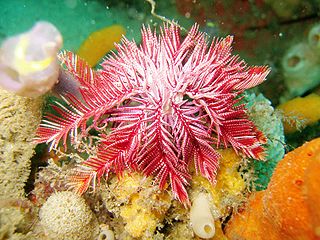
Articulata are a subclass or superorder within the class Crinoidea, including all living crinoid species. They are commonly known as sea lilies or feather stars. The Articulata are differentiated from the extinct subclasses by their lack of an anal plate in the adult stage and the presence of an entoneural system. Articulata first appeared in the fossil record during the Triassic period although other, now extinct crinoid groups, originated in the Ordovician.
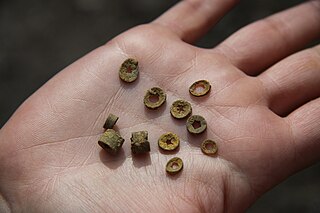
St. Cuthbert's beads are fossilised portions of the "stems" of crinoids from the Carboniferous period. Crinoids are a kind of marine echinoderm which are still extant, and which are sometimes known as "sea lilies". These bead-like fossils are washed out onto the beach and in medieval Northumberland were strung together as necklaces or rosaries, and became associated with St Cuthbert.
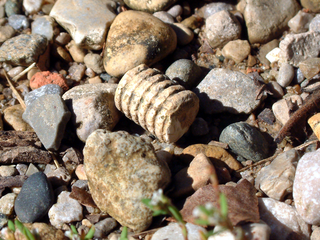
Indian bead is a colloquial American term for a fossilized stem segment of a columnal crinoid, a marine echinoderm of the class Crinoidea. The fossils, generally a centimeter or less in diameter, tend to be cylindrical with a small hole along the axis and can resemble unstrung beads. The fossils are abundant in certain areas, including parts of the American Midwest where they are present in gravel. They are sometimes also referred to as "Indian money".

Platyceratidae is an extinct family of Paleozoic sea snails, marine gastropod mollusks. This family may belong in the Patellogastropoda or the Neritimorpha.

Iocrinus is an extinct genus of crinoid. It is an early form of crinoid, from the Ordovician rock of North America, England, and Gilwern Hill, Powys in Wales.

Encrinus is an extinct genus of crinoids, and "one of the most famous". It lived during the Late Silurian-Late Triassic, and its fossils have been found in Europe.

Comatulida is an order of crinoids. Members of this order are known as feather stars and mostly do not have a stalk as adults. The oral surface with the mouth is facing upwards and is surrounded by five, often divided rays with feathery pinnules. Comatulids live on the seabed and on reefs in tropical and temperate waters.

Paleontology in Indiana refers to paleontological research occurring within or conducted by people from the U.S. state of Indiana. Indiana's fossil record stretches all the way back to the Precambrian, when the state was inhabited by microbes. More complex organisms came to inhabit the state during the early Paleozoic era. At that time the state was covered by a warm shallow sea that would come to be inhabited by creatures like brachiopods, bryozoans, cephalopods, crinoids, and trilobites. During the Silurian period the state was home to significant reef systems. Indiana became a more terrestrial environment during the Carboniferous, as an expansive river system formed richly vegetated deltas where amphibians lived. There is a gap in the local rock record from the Permian through the Mesozoic. Likewise, little is known about the early to middle Cenozoic era. During the Ice Age however, the state was subject to glacial activity, and home to creatures like short-faced bears, camels, mammoths, and mastodons. After humans came to inhabit the state, Native Americans interpreted the fossil proboscidean remains preserved near Devil's Lake as the bones of water monsters. After the advent of formal scientific investigation one paleontological survey determined that the state was home to nearly 150 different kinds of prehistoric plants.
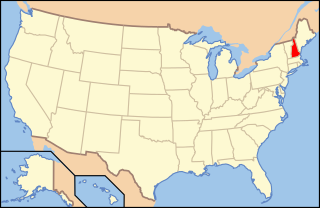
Paleontology in New Hampshire refers to paleontological research occurring within or conducted by people from the U.S. state of New Hampshire. Fossils are very rare in New Hampshire because so much of the state's geology is highly metamorphic. The state's complicated geologic history has made dating its rocks and the fossils they contain "a difficult task." The state's Devonian rocks are especially metamorphosed, yet its Mississippian rocks formed too recently to have been subject to the same metamorphism. Nevertheless, despite the geologic complications some fossils have been discovered in the state.

Paleontology in Missouri refers to paleontological research occurring within or conducted by people from the U.S. state of Missouri. The geologic column of Missouri spans all of geologic history from the Precambrian to present with the exception of the Permian, Triassic, and Jurassic. Brachiopods are probably the most common fossils in Missouri.

Agaricocrinus americanus, the mushroom crinoid, is a species of extinct crinoid, known only from its fossils, which are found in the U.S. states of Indiana, Tennessee and Kentucky. They date back to the Lower Mississippian, about 345 million years ago.

Bourgueticrinida is an order of crinoids that typically live deep in the ocean. Members of this order are attached to the seabed by a slender stalk and are known as sea lilies. While other groups of crinoids flourished during the Permian, bourgueticrinids along with other extant orders did not appear until the Triassic, following a mass extinction event in which nearly all crinoids died out.

Cladida is a major subgroup of crinoids with a complicated taxonomic history. Cladida was originally applied to a wide assortment of extinct crinoids with a dicyclic calyx. Under this original definition, cladids would represent a paraphyletic order ancestral to several other major crinoid groups, particularly the living Articulata. More recently, Cladida has been redefined as a monophyletic parvclass of pentacrinoids which encompasses articulates and the extinct Flexibilia (flexibles). Cladids also include various minor taxa such as the hybocrinids and "cyathocrines". As flexibles were not originally considered cladids, the new subgroup Eucladida has been erected for cladids which are more derived than flexibles. Cladida is the sister group to Disparida, another large group of extinct crinoids.

The Camerata or camerate crinoids are an extinct subclass of Paleozoic stalked crinoids. They were some of the earliest crinoids to originate during the Early Ordovician, reached their maximum diversity during the Mississippian, and became extinct during the Permian–Triassic extinction event. Camerates are the sister group of Pentacrinoidea, which contains all other crinoids. The two largest camerate subgroups are the orders Diplobathrida and Monobathrida.
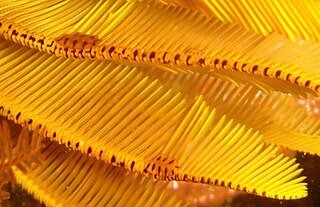
Myzostoma fuscomaculatum, the crinoid worm, is a species of marine worm in the family Myzostomida.

The Burlington Limestone is a geologic formation in Missouri, Iowa and the Midwest region. It preserves fossils dating back to the Mississippian subperiod.